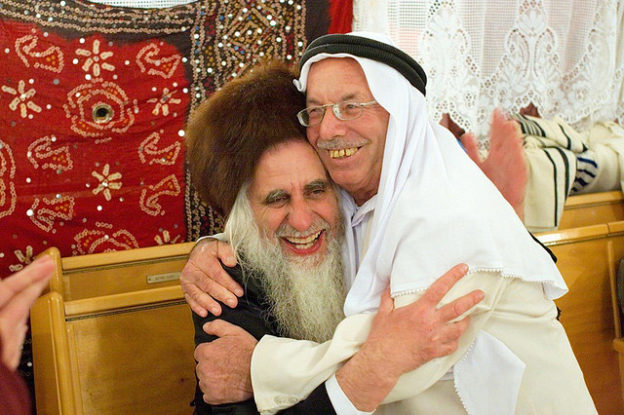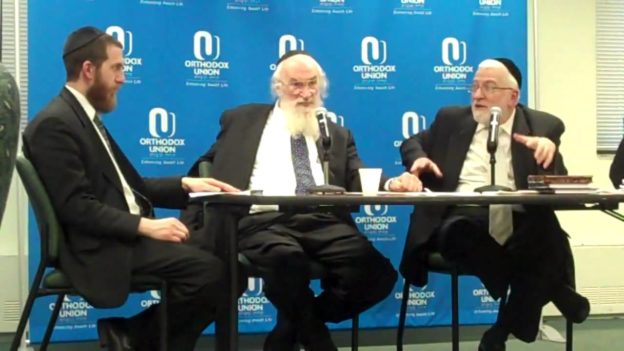An article about an inconsistency in the heterodox Jewish movements’ attitudes appears on Tablet, and can be read here.
Category Archives: News

Truth Is Attractive
It wasn’t a phone call the head of the Union for Reform Judaism ever wanted to get. Taglit-Birthright was calling, with bad news.
In the U.S., the “Taglit” (“discovery”) part of the name of the non-profit organization that sponsors free ten-day trips to Israel for Jewish young adults is usually dropped; it is known simply as “Birthright.”
Founded in 1994 by two philanthropists, Wall Street money manager Michael Steinhardt and former Seagram Company chairman Charles R. Bronfman, Birthright is financed by them and other private donors, as well as by the Israeli government. More than 500,000 young people, mostly from the U.S. and Canada, have participated in the program to date.
The recent phone call was to inform the Reform leader that his movement was no longer authorized as a certified trip provider for Birthright. It wasn’t, the caller explained, because Birthright had anything against “progressive” Jewish groups, but rather a simple matter of the fact that the Reform movement had failed to meet participant quotas.
“We worked very hard with them to increase the numbers,” Birthright CEO Gidi Mark told an Israeli newspaper, “but unfortunately they could not meet our minimum.”
Although the overwhelming majority of Birthright participants come from non-Orthodox backgrounds – less than 5 percent are Orthodox Jews – Orthodox-affiliated trip providers, including the Chabad-connected group “Mayanot,” the Orthodox Union’s “Israel Free Spirit” and Aish Hatorah account for close to a quarter of total recruitment.
Birthright’s largest single donor these days is Republican supporter Sheldon Adelson. He is a promoter of the Israeli political right wing with regard to security issues and the Palestinians, but is not Orthodox. Messrs. Bronfman and Steinhardt say, “We are both secular Jews… we never saw Birthright Israel as a religious trip, though many alumni have changed their ritual practices.”
So why have Orthodox groups emerged as so disproportionate a conduit of young non-Orthodox Jews to Birthright trips?
Rick Jacobs, the president of the Union for Reform Judaism, who bemoans that fact, blames it on the Israeli government’s support for what he calls “Ultra-Orthodox campus institutions.” He also is upset that young people on Birthright trips are given the option, if they choose, to attend Orthodox services during their stay in Israel.
Reform leaders are also chagrined that, although “religious indoctrination” is prohibited on Birthright trips, the Orthodox groups also often later convince Birthright alumni to, in Rick Jacobs’ words, “explore a more traditional way of Judaism.” The horror.
Asked about Orthodox organizations’ outreach work with participants after the trips, Mr. Mark said: “We are dealing with people who are very intelligent. They are all mature people older than 18. I myself never heard any one complaint about any misuse of the relationship by our trip organizers.”
Rather than stew over the fact that nonobservant young Jews seem to gravitate to groups dedicated to “a more traditional way of Judaism” – or, put more accurately, the authentic mesorah of Klal Yisrael – Reform leaders might stop seeking culprits for that offense and consider the fact that emes, truth, is attractive.
Birthright certainly has never pushed Yiddishkeit in any way, and indeed shunned anything smacking of “religious indoctrination.”
It has helped ensure Jewish continuity by helping countless Jews connect in one or another way to their religious heritage by bringing them to Israel.
But for nearly 2000 years, visiting or settling in Eretz Yisrael was not even an option for most Jews. What sustained Jewish continuity over those millennia? Precisely Rick Jacobs’ “more traditional way of Judaism” – Jewish knowledge and Jewish living.
In fact, if Birthright really wanted to maximize its bang for the buck, it might consider dropping altogether its religious rejection of religion and consider a marvelous, gutsy move. Namely, amend Birthright’s existing program to maximize the Jewish impact of the gift it offers young Diaspora Jews, by providing them, say, for two or three of their ten days, an intensive Jewish learning experience in an Israeli yeshivah, seminary or outreach program catering to Jews from overseas.
Yes, that would violate the effort’s heretofore commitment to “pluralism.” But it would be entirely in consonance with Birthright’s professed goal, helping ensure Jewish continuity.
In fact, providing Jews who were raised distant from their religious heritage the opportunity to witness what it means to live a true Jewish life would be nothing less than, well, returning to them their birthright.
© 2017 Hamodia

Gezunt or Glucophobia?
Have you been following the U.S. Department of Agriculture’s advice to drink three cups of milk a day, to get enough calcium and vitamin D? No? Good for you.
Multiple studies show that there is no association between drinking so much milk (or taking calcium and vitamin D supplements) and fewer bone fractures.
Do you take a multivitamin every day? No? Good for you. Decades of research have yielded no justification for healthy people taking vitamins.
Have you at least been cutting down on coffee and keeping it from your kids, so as not to stunt their growth? No, again? Well, good for you again.
Drinking a few cups a day, it turns out, has been linked to substantial health benefits; and most research finds no correlation between children’s caffeine consumption and their bone growth.
Every generation assumes that its conclusions about scientific matters are the last word, despite the fact that they often aren’t.
Sometimes, wrong conclusions are innocent and excusable, the products of tainted data, poorly designed experiments or human error.
Other times, though, misinformation is purposely fed to the public for particular parties’ financial gain. In the case of coffee, for instance, it was villainized largely by cereal manufacturer C.W. Post, in an effort to market his “Postum” product as an alternative to what he called “nerve poison” that should never be served to children.
Enter the revelation last week about sugar. Scientists at the University of California, San Francisco, announced that they have uncovered documents demonstrating that, back in the 1960s, members of the sugar industry called off a study, named Project 259, because it linked sugar to heart disease and bladder cancer in preliminary experiments.
Last year, the same researchers discovered a document that showed the sugar industry funded a report that downplayed links between sugar and coronary heart disease.
UCSF dentist Cristin Kearns started digging into the sugar industry 10 years ago, after hearing representatives at a conference say there is “no scientific consensus” that sugar is linked to chronic illnesses. She combed through library archives across the nation and eventually came upon a box containing “confidential” documents on “Project 259.”
In 1968, the Sugar Research Foundation launched a rodent study, which measured the nutritional products of gut bacteria after rats consumed sucrose, as compared to starch.
The experiment’s early results showed that sucrose increased the poor animals’ levels of triglycerides, fatty molecules that, in humans, can clog arteries and predispose a person to heart attacks and strokes.
Another preliminary experiment in the project also found a high-sugar diet boosts the activity of an enzyme linked to bladder cancer.
After reporting this discovery in August, 1970 to the International Sugar Research Foundation, Project 259 scientists requested more time and funding to continue the research, the documents show. But the request was denied, and the project abandoned.
Dr. Kearns and UCSF cardiologist Stanton Glantz claim that the sugar industry tried to bury the evidence and stopped the project because of the negative findings.
A sugar industry spokesperson dismissed that claim as “a collection of speculations and assumptions about events that happened nearly five decades ago.” It also called the researchers “known critics of the sugar industry.” Glucophobics, as it were.
In 2004, a trial revealed that tobacco industry officials had intentionally deceived Americans for years into thinking that smoking did not cause cancer, despite having clear evidence to the contrary.
No trial is in the works at present for Big Sugar, but the parallel is there. Sugar might not smell bad or turn teeth yellow. But too much of it can, over time, be deadly.
The recent report isn’t the first to reveal the sugar industry’s machinations, either.
According to an analysis of historical documents published in the journal JAMA Internal Medicine, when studies first began linking sugar with heart disease, a sugar industry group paid Harvard researchers to write an article about the issue.
Published in 1967, it played down the effects of sugar and concluded that the only dietary intervention needed to prevent heart disease was reducing cholesterol and saturated fat. Which led to the decades-long, aggressive marketing of an assortment of “low fat” products – that, incidentally, contained more sugar than their regular counterparts.
The American Heart Association recommends that men consume less than 150 calories of added sugar per day; and women, less than 100.
There are 16 calories in a teaspoon of sugar. A 12-ounce can of regular soda contains about 9 teaspoons of sugar.
Do the math. And, remembering the Torah’s exhortation to guard our health, do the right thing for your health.
© 2017 Hamodia

Peter Beinart’s Orthophobia
Below is my original draft of a piece I wrote for Forward. The article as it appeared there, though, was substantially edited, and several sentences that I think are important were omitted. So I share the original here. The Forward piece can be read here.
Well, in case anyone for some reason may have been wondering, Peter Beinart, who recently wrote a piece titled “The Orthodox Should Know Better than to Embrace Hatred of Muslims,” doesn’t follow J.K Rowling on Twitter.
Because if the Forward senior columnist and former The New Republic editor did, he would have seen Harry Potter’s creator’s retweet last year of a haredi (or in the Forward’s pejorative preference, “ultra-Orthodox”) rabbi’s message.
The rabbi shared the fact that he had dedicated his presidential election vote to the American Muslim soldier Captain Humayun Khan – who was killed in combat and about whom his father Khizr spoke movingly at the Democratic National Convention. Then-candidate Donald Trump, of course, was then touting his “Muslim ban.”
The Hasidic rabbi, who serves as a media relations coordinator at the national Orthodox Jewish organization Agudath Israel of America (full disclosure: I work there too), shared a photo of himself holding his ballot, alongside a photo of Captain Khan and his gravestone. He wrote that he wanted to highlight how Captain Khan’s “devotion makes (religious) freedom possible.”
The tweet was liked almost 12,000 times and retweeted 5,496 times, including Ms. Rowling’s sharing of the photo and message with her 13 million followers. Not one of whom, apparently, is Mr. Beinart, who wrote recently here that “the inability to distinguish jihadist terrorism from Islam fuels American Jewish hostility toward American Muslims” and that such inability is “particularly true among the Orthodox.”
Mr. Beinart must have also missed the story of the haredi director of a Brooklyn soup kitchen who, after the election, rallied support within his community for Muslim Yemeni neighbors who were protesting the new president’s executive order banning immigration from seven Muslim-majority countries. The haredi also organized support for a beleaguered local Yemeni-owned bodega, complete with “Shalom/Salaam” posters.
Agudath Israel, moreover, issued a pro-immigration statement about the ban asserting that such a move is acceptable only if intended to prevent terrorists from entering the country, only “if tempered by true concern for innocent refugees” and only if “its focus is on places,… not on religious populations.”
Mr. Beinart could be forgiven for not knowing about the hassidic WhatsApp group that calls itself “Isaac and Yishmoel,” created to enable its members to defend unfairly maligned Muslims.
But some research on his part might have turned up the fact that Agudath Israel’s executive vice president chairs the Committee of New York City Religious and Independent School Officials, which includes representation from the Islamic School Association. And that he has worked with Islamic school representatives on a number of issues before the New York State Education Department. And that, on the national level, he works with Islamic school groups under the umbrella of the Council for Private Education.
Agudath Israel has also joined with Islamic groups in amicus briefs in religious liberty cases, and, along with the Orthodox Union, another major national group, has opposed “anti-sharia” laws.
Is there wariness about Muslims among many Orthodox Jews? Yes, as there is among many non-Orthodox ones, among many Episcopalians, Catholics and Hindus too. Is that fair to the vast majority of Muslim citizens, who have no evil designs? No. But, unfortunately, the proclaimed world-conquering designs of Islamists and the malevolent acts committed by extremists exist. The distrust that results is, unfortunately, the responsible Muslim’s unfair burden to bear.
But do Orthodox Jews hate Muslims or seek to harm them? Mr. Beinart should visit one of the Brooklyn neighborhoods where Orthodox Jews and Muslim immigrants live side by side, day by day without friction.
The Forward columnist compounds his slander of Orthodox Jews by engaging in some Orthophobia, in effect accusing haredim of preventing women from marrying, touting genocide and killing babies. Yes, you read right.
There isn’t space here to rebut such outlandishness. Suffice it to say that it is a high haredi ideal to find ways to compel a recalcitrant husband to agree to divorce his abandoned wife; that no people today can be identified with Amalek, and so the biblical injunction to destroy that evil nation cannot be applied; and that metzitza bipeh, the oral suction practiced by some haredim as part of the Jewish circumcision rite, has never been proven to be related to, much less the cause of, any infection in an infant, as three medical/statistics experts have affirmed (http://forward.com/opinion/letters/194118/no-conclusive-evidence-on-circumcision-rite-and-he/) in these very pages.
The Orthodox community’s final crime, in the Beinart courtroom, is having voted in large numbers, and in contrast to the larger Jewish community, for the man currently occupying the White House. Judge Beinart chooses to interpret that fact as the result of Orthodox anti-Muslim sentiment.
Might it be, though, that many haredim simply recognize that judicial appointments comprise one of the most influential powers any president has? And felt that Mr. Trump’s likely choices would prove more sensitive to our community’s concerns about societal issues and the potential erosion of religious rights in America?
We must plead guilty – forgive us – to the charges of being social conservatives and religious rights activists. But not to Mr. Beinart’s ugly and incendiary charge.

Of Bump Stocks and Background Checks
The landscape of Devin P. Kelley’s life was a veritable forest of red flags.
Mr. Kelley, who last week shot to death 26 worshippers in a Texas church and wounded some 20 others, over the years was convicted of beating his wife and stepson, fracturing the latter’s skull; faced charges of animal cruelty; had been investigated for threats against family members; threatened to kill his military superiors; was caught sneaking guns onto an Air Force base; and escaped from confinement in a mental health facility.
The Air Force has admitted that it did not, as required, submit Mr. Kelley’s name to federal authorities for inclusion in a national database that would have prevented him from buying firearms from a licensed dealer.
But there is a two-word phrase in the previous paragraph that conveys the fact that, even had every red flag in the killer’s life been noticed, even had more neighbors reported him, even had the Air Force done its duty, the murderer would still have had no problem procuring his murder weapon – a AR-15-style rifle, the same sort used by the mass killers in Las Vegas last month, Orlando last year and Sandy Hook Elementary School in 2012. (It’s also customizable; adding a “bump stock” can turn the semi-automatic into a virtual machine gun. Sweet.)
The phrase? “Licensed dealers.” Federal law does not require background checks for people buying firearms from other private individuals, as takes place regularly at gun shows across the country. Some states require private sale background checks, but most do not. Texas does not.
That loophole, through which any determined would-be killer can easily pass, was decried by past presidents Bill Clinton, George W. Bush and Barack Obama, to no avail. The NRA argues, with members of Congress nodding their heads obediently, that there are illegal ways for criminals to purchase guns too, so why burden citizens to check a federal registry before selling a semi-automatic rifle to a fellow citizen? One wonders if those congressmen lock their front doors. There are, after all, burglars out there with crowbars.
Asked after the recent massacre about intensified vetting of gun purchases, President Trump responded that the murderer was a “very deranged individual,” and that tighter gun control might have prevented “that very brave person who happened to have a gun” from shooting the killer and averting more casualties.
But that brave man would likely have passed a background check . And, for the record, he didn’t stop the massacre; he shot Kelley only after the killer had left the church.
As to the perpetrator’s mental health, the mentally ill are no more prone to violence than the general population. As Paolo del Vecchio of the federal Substance Abuse and Mental Health Services Administration put it: “Violence by those with mental illness is so small that even if you could somehow cure it all, 95 percent of violent crime would still exist.”
So why was America’s gun homicide rate 33 per million people in 2009, while in Canada and Britain, it was 5 per million and 0.7 per million, respectively? Why, as a The American Journal of Medicine study last year reported, are Americans 10 times more likely to be killed by guns than people in other developed countries?
The only variable that explains the high rate of gun deaths in America is – you may want to sit down – the number of guns in America, and the ease with which we Americans can obtain them.
We make up about 4.4 percent of the global population but own 42 percent of the world’s guns, according to a 2015 study by University of Alabama professor Adam Lankford. The U.S., moreover, has some of the weakest controls of any developed country over who may buy a gun and what sorts of guns may be owned.
Yet, despite the events of recent weeks (and months, and years), gun control remains a frightening phrase to many Americans and their legislators. British journalist Dan Hodges noted with tragic resignation: “In retrospect, Sandy Hook [the 2012 attack that killed 20 students at a Connecticut elementary school] marked the end of the U.S. gun control debate. Once America decided killing children was bearable, it was over.”
The aforementioned Mr. Obama, whose own calls for more gun regulations were stymied by the legislature, reacted to last week’s massacre with a prayer. “May G-d… grant all of us the wisdom,” he wrote, “to ask what concrete steps we can take to reduce the violence and weaponry in our midst.”
Worthy, to my lights, of a national amen.
© Hamodia (in a slightly edited version)

Agudath Israel of America: “Jewish Pluralism” Undermines True Jewish Unity
In advance of Israeli President Reuven Rivlin’s address to the Jewish Federations of North America’s General Assembly, that group passed a resolution on “Jewish pluralism” in Israel, opposing a bill to enshrine a single conversion standard in the country and asserting that the Israeli Government’s decision to freeze an agreement about the Western Wall has “deep potential to divide the Jewish people.”
It is sadly ironic, although not surprising, that leaders of heterodox movements that have in fact undermined true Jewish unity and continuity by inviting intermarriage and breaking away from the Jewish religious heritage have of late been lecturing others about Jewish unity.
More disappointing still are the unity-cries of the Jewish Federation movement. The historic role of Jewish federations has been to provide support and solace for disadvantaged or endangered Jews and to mobilize the community to come to Israel’s aid when it is threatened. Taking sides in religious controversies anywhere, and certainly in Israel, egregiously breaches the boundaries of that role.
The Jewish Federations of North America, moreover, has traditionally sought to represent all of American Jewry, but here it entirely ignores the feelings of the substantial and growing American Orthodox community.
The Reform and Conservative movements, despite their great efforts over decades, have few adherents in Israel. Most of their members do not visit or settle in Israel, nor do they visit the Western Wall in large numbers. And yet their leaders seem prepared to offend the religious sensibilities of their Orthodox brethren, who regularly visit and move to Israel, and who come to the Kotel to pour out their hearts to G-d there. A holy place should not be balkanized, nor wielded as a tool to advance partisan social goals.
And the patchwork of standards for conversion that exist in America has created an Ameican Jewish landscape where those who respect halacha as the ultimate arbiter of personal status cannot know who is in fact Jewish. Creating in Israel a multiplicity of “Jewish peoples,” as is the tragic reality in America, would not foster unity but its opposite.
To our dear Jewish brothers and sisters, we say: Please do not push for changes at the Kotel that will only cause discord and pain to the vast majority of Jews who worship there. And please realize that the conversion standards that have ensured Jewish unity for millennia are the only ones that can preserve it for the future.

The Price of Tea in Uzbekistan
As commuters made their way home from lower Manhattan last Tuesday evening, the police presence was strong, complete with heavily armed officers, helicopters and dogs. At that point, no one knew if the man currently charged with ramming a truck into people on a nearby bike path, killing eight and injuring twelve, was part of a larger terrorist plan or a lone wolf.
The show of vigilance may have made people feel safer. It may even have made them safer, since a broader police presence can, in the event of a terrorist act like last week’s, prevent worse outcomes. The unfortunate fact, though, remains that it is simply impossible to prevent evil people from doing evil things.
To be sure, we must make what reasonable efforts we can to prevent depraved people from entering our country, from plotting to commit violent acts and from carrying them out.
But the carnage caused by Uzbek immigrant Sayfullo Saipov is illustrative of how it isn’t really possible to prevent malevolent individuals – who proliferate so easily these internet days – from wreaking havoc when they choose to.
The accused Manhattan killer was in the country legally, holding a green card, a beneficiary of the “diversity visa lottery,” by which approximately one million foreigners have been awarded legal permanent residency in the U.S., despite having no relatives here or special skills.
President Trump was quick to blame that program for the recent attack, and claimed that New York Senator Chuck Schumer was at fault. The senator was indeed one of those who helped create the program in 1990. He was also, though, among senators who proposed to end it several years ago.
But the issue of the visa lottery has as much to do with what happened in Manhattan last week as it does with the price of tea in Uzbekistan.
The truck terrorist (I’ll drop the “accused”; the fiend has expressed joy over and pride in what he did) seems to have been radicalized after his arrival on these shores, apparently when he wandered from job to job and didn’t land the one he wanted. When he was chosen in the 2010 visa lottery, he was subject to the same vetting procedures as any immigrant, and raised no concerns. Someone approved to immigrate because of special skills or relatives here can also become radicalized.
As can someone born here. The nonpartisan think tank New America tallied the citizenship status of 418 individuals accused of jihadist terrorism crimes in the U.S. since 9/11, and found that fully 85 percent of them were either U.S. citizens or U.S. legal residents – about half of them born American citizens.
And then there is non-jihadi violence against innocents, like last month’s attack in Las Vegas, where a born American killed 58 people and wounded 489. The very day after the more recent terrorist act, a gunman (with no connection to Islam, much less Islamism) walked into a Colorado Walmart and nonchalantly killed three people. And then, this past Sunday, a man shot 26 people to death at a Texas church.
Some, frustrated at the lack of a good blamee (well, it should be a word) for last week’s attack in Manhattan, consider the company that rented Mr. Saipov a truck to bear some responsibility for his actions. But on what grounds should he have been refused? His name? His beard? His religion? His country of origin? Anyone with a valid driver’s license and a credit card can rent a vehicle. Did that fact facilitate last week’s violence? Surely. Can it be applied selectively without violating federal law? Just ask a lawyer.
Restricting immigration may be a good idea (though if Uzbekistan is blacklisted, that will affect the Bukharian Jewish community still there). Careful vetting of foreigners entering the country surely is. But neither notion is a solution to terrorism. Nor, although a fine idea whose time has long arrived, is tougher gun control.
I have come up with several theoretical but entirely workable ideas for sneaking weapons onto public transportation, including onto planes (no, I’m not telling). I imagine similar ones have been conceived by people inclined, as I am not, to killing or maiming innocents.
So what is the solution to terrorism? A secret: There is none. And no one, or thing, to blame when evil is wrought.
There are prudent steps to be taken, yes. But if we think any or all of them can prevent bad people from doing bad things, or that some policy or law is at fault when they do, we fool ourselves.
We might better ponder a passuk: “If Hashem will not guard a city, in vain does its guard keep his vigil” (Tehillim 127:1).
And recognize the import of its message.
© 2017 Hamodia

The Art of the Decertification
What does President Trump’s decertification of the Iran deal mean, and what does it mean?
That wasn’t a mistake. There are two questions here. What exactly it is that the president did, and what does it herald for the world’s future.
What he did:
Back in 2015, then-President Obama approved the international agreement to restrict Iran’s advancing nuclear program. But the deal wasn’t an actual treaty, which would have required Senate approval. Skeptical lawmakers wanted to assert some sort of control over the accord, and so Senators Bob Corker (yes, that one) and Ben Cardin helped pass bipartisan legislation, the Iran Nuclear Review Act (INARA), requiring the president to certify important aspects of the deal to Congress every 90 days.
Heeding the advice of his foreign-policy advisers, President Trump did so twice. When the third deadline arrived this month, though, he opted not to, claiming that Iran is violating the terms of the agreement – or, as Secretary of State Rex Tillerson clarified, its “spirit.”
While United Nations inspectors, the other parties to the deal and even top Trump administration officials (including Mr. Tillerson, Defense Secretary Jim Mattis and the chairman of the Joint Chiefs of Staff, Joseph Dunford) maintain that there haven’t been substantive Iranian violations of the deal, and that Iran’s nuclear program has been halted for now, the president, who repeatedly denounced the deal during the presidential campaign, concluded that, nevertheless, the time has come to force its renegotiation.
He could have just pulled the U.S. out of the deal – a president created it, and a president can extinguish it – but instead opted to simply not certify the agreement, punting its fate, at least for now, to Congress.
And so we’re brought to the second question: What does the president’s recent action mean – for the future?
It’s not hard to make a case that, despite its abiding by the terms of the deal, the Iranian regime is belligerent and dangerous. It has gone full speed ahead with its ballistic missile program (which falls outside the nuclear agreement) and is deeply involved in murderous mischief in places like Syria and Lebanon. It has harassed American ships in the Persian Gulf and underwritten Hezbollah’s operating budget. It credibly competes with North Korea for first prize in the category of malevolence.
Still, insisting on major new concessions from Iran – which President Trump wants Congress to do – or pulling out of the Iran deal altogether, as he has threatened to do if Congress fails him, could result in a colossally sticky wicket. Right off the bat, it will provide Iran an excuse to fully resume its nuclear weapons program. The mullahs have already gone ballistic in the literal sense with their missile program; they might well be expected to do the same in the phrase’s figurative sense.
Iran’s “Supreme Leader” Ayatollah Ali Khamenei has already announced that “If the U.S. tears up the deal, we will shred it.”
A mere two years ago, U.S. and Israeli intelligence measured the breakout time for an Iranian nuclear weapon in weeks. Currently, due to the deal, that can is kicked down the road at least 15 years (by which time Iran may have a new, less lunatic leadership; and, if not, the military options considered two years ago can be reconsidered). Should the deal be abrogated, though, we’re back to 2015.
Then there is the expected fallout from the U.S. reneging on an agreement, even one that isn’t an actual treaty. Russia and China, as signatories of the Iran deal, will question whether the United States can be a reliable negotiating partner, at a time when cooperation among the major powers is vital in fighting radical Islam. And if there currently exists any hope that diplomacy might mitigate North Korea’s designs, there won’t be then.
So the president is taking a serious gamble, with much at stake.
Ironically, though, the very recklessness that Mr. Trump seems to project could win him the endgame here. Because it is at least conceivable that Iran’s leaders, for all their bluster, in fact feel endangered by a seemingly unrestrained American leader who openly threatens his country’s enemies with utter destruction.
Part of what propelled Mr. Trump to the presidency was his proclaimed success as a dealmaker. Might his Iranian gambit turn out to have been a shrewd move that yielded not World War III but long-term security for the civilized world?
We must hope it will and, more important, be mispallel that lev melech here will be firmly b’yad Hashem (Mishlei 21:1).
© 2017 Hamodia

Two Apologies, One Disagreement and a Reiteration
In an article for the Jewish feminist group JOFA, Dr. Noam Stadlan objects to what I wrote in the Forward about the Orthodox Union’s stance on women being appointed as Jewish clergy.
His objections are several, and I will respond briefly to each below. But, as explained a bit further below, the doctor glosses over the most salient, central point of what I wrote.
Dr. Stadlan is correct that I did not acknowledge the fact that there are Orthodox circles where women study Talmud. My apologies for that omission, but what texts are appropriate for formal teaching of women was not my topic.
Whether any recognized poskim consider it proper for women to speak before men was likewise not my topic. My en passant reference to women speaking to women was written from my personal experience (though not only in “haredi” shuls), and I apologize here too if it inadvertently insulted anyone.
I strongly disagree, though, with Dr. Stadlan’s stark judgment that it is somehow out of bounds for someone like me who looks to haredi poskim for guidance to offer an opinion about a challenge faced by a “Modern Orthodox” organization committed to halacha. I think, on the contrary, that it reflects a feeling of concern for other halacha-respecting Jewish communities than one’s own. (Incidentally, as the bio at the end of my Forward piece indicates, I wrote my piece as an individual Jewish blogger, not in the name of Agudath Israel, which is mentioned only afterward for identification purposes.)
Most important, Dr. Stadlan seems to misunderstand the essence of what I wrote. I did not set out to make a halachic case “against the ordination of women.” I am not qualified as a posek, and would never arrogate to write as one. It may well be the case, as some writers cited by Dr. Stadlan assert, that a “halachic case can be made for the ordination of women.”
What I wrote – and this is the central point Dr. Stadlan somehow misses – was that the question of women rabbis, which may be a legitimate one and is certainly one of great societal import today, was responsibly placed by the Orthodox Union before poskim to whom it looks for halachic guidance.
There is, pace Dr. Stadlan, no Jewish concept of halacha divorced from recognized poskim qualified to apply halachic principles (and, yes, meta-halachic principles no less, which have always been and remain very much part of reaching authoritative halachic decisions). Whom one turns to for a psak is one’s own business, but acknowledging that there are widely recognized and respected poskim in various communities (be they “centrist”, “yeshivish”, or any particular flavor of Chassidic) is not a “no true Scotsman fallacy”; it is the very essence of how halacha has been applied over history to new circumstances – and how it must be responsibly applied today.

Sullied Reputation
The rioting last month in St. Louis following the acquittal of a white former police officer who killed an African-American man, like all rioting in the wake of unpopular verdicts, was ugly and unjustifiable. While the majority of protesters were peaceful, some hoodlums broke store windows and threw rocks at police.
The city’s acting police chief, Lawrence O’Toole, came under fire for stating, after calm was restored, “I’m proud to tell you the City of St. Louis is safe, and the police owned tonight.” Georgetown law professor Paul Butler retorted that if “the police actually are in charge, if they actually own the night, that’s a police state, not a free country.”
He’s wrong. Empowered police are essential to a free country.
The Mishnah (Avos 3:2) teaches that governments are what prevent anarchy, and thus deserve our tefillos. And law enforcement officers are the front line of maintaining the peace.
What spurred the largely peaceful protests, though, shouldn’t escape our attention.
The police officer acquitted of murder, Jason Stockley, and his partner chased a suspected criminal, Anthony Smith, who had fled in a car. The officers slammed their SUV into the suspect’s car. Officer Stockley got out and fired five shots, killing the suspect. A handgun was taken from the car after the shooting.
The police vehicle’s dashboard camera, however, shortly before the chase ended, captured Mr. Stockley seeming to say that he was “going to kill this [expletive].” At trial, the officer said he could not remember saying that.
Prosecutors also argued that the presence of Mr. Stockley’s DNA – and the absence of Mr. Smith’s – on the retrieved gun proved that Mr. Stockley planted the weapon on the suspect’s person. (More than 40 criminal cases have been dropped in Baltimore alone after police body cameras show officers there allegedly planting evidence.)
The judge, though, noted the lack of any direct evidence of wrongdoing; cited court testimony that the absence of someone’s DNA on a gun is not conclusive; and opined that for a person engaged in criminal activity to “not [be] in possession of a firearm would be an anomaly.”
I won’t second-guess the judge. He heard all the testimony and saw all the evidence, and I didn’t. But it’s understandable why the outward facts of the case led some in St. Louis to voice their displeasure.
Police officers facing criminals they believe are armed need to make split-second decisions, and cannot be expected to pause to meditate on their situation. Still and all, police misconduct happens.
Like it did in the bloodless but still deeply disturbing case of Fred Watson, who was sitting in his car in a Ferguson, Missouri park in 2012 when a police officer approached, searched the man’s car without permission and wrote him more than half a dozen tickets. Among them was one for not wearing a seatbelt, even though the car was parked; and one for offering a false report – because Mr. Watson identified himself as “Fred” instead of the “Freddie” on his license.
Mr. Watson, a Navy veteran and cybersecurity expert, is black. According to his account, when he protested the citations, the white officer pulled out his gun and told him: “I could just shoot you right here and no one would” care.
A case of “he said, he said”? Maybe. But the officer’s record shows that he pistol-whipped a 12-year-old girl in the face in 2006, and in 2007 struck another child in the face with something metal before falsifying a police report.
Meanwhile, Mr. Watson said that the city’s five-year-long prosecution caused him to lose his security clearance, resulting in his being fired from his well-paying cybersecurity job. Last month, without explanation, Ferguson prosecutors dropped all charges. Better late than never.
It isn’t always white on black mistreatment, either. This past July, a black police officer in Coney Island ordered a white man, Raymond Crespo, to pick up a cup his friend had knocked from his hand. When Mr. Crespo didn’t, the officer threw him against a door and then threw him down and dragged him along the ground – all captured by a surveillance camera. Mr. Crespo filed a complaint.
The next day, Mr. Crespo says, the officer, in plainclothes, sought him out, asked him why he had made the complaint and, revealing a gun in his waistband, said, “Do you know what I’m going to do to you?”
There is no inconsistency in both wholeheartedly supporting police and being deeply distressed by police misconduct. Quite the contrary, for those of us who truly value the dedication of law enforcement personnel, the irresponsible yechidim in their ranks are all the more loathsome, for they only sully the good reputation of the vast majority of police, unfairly but surely.
© 2017 Hamodia